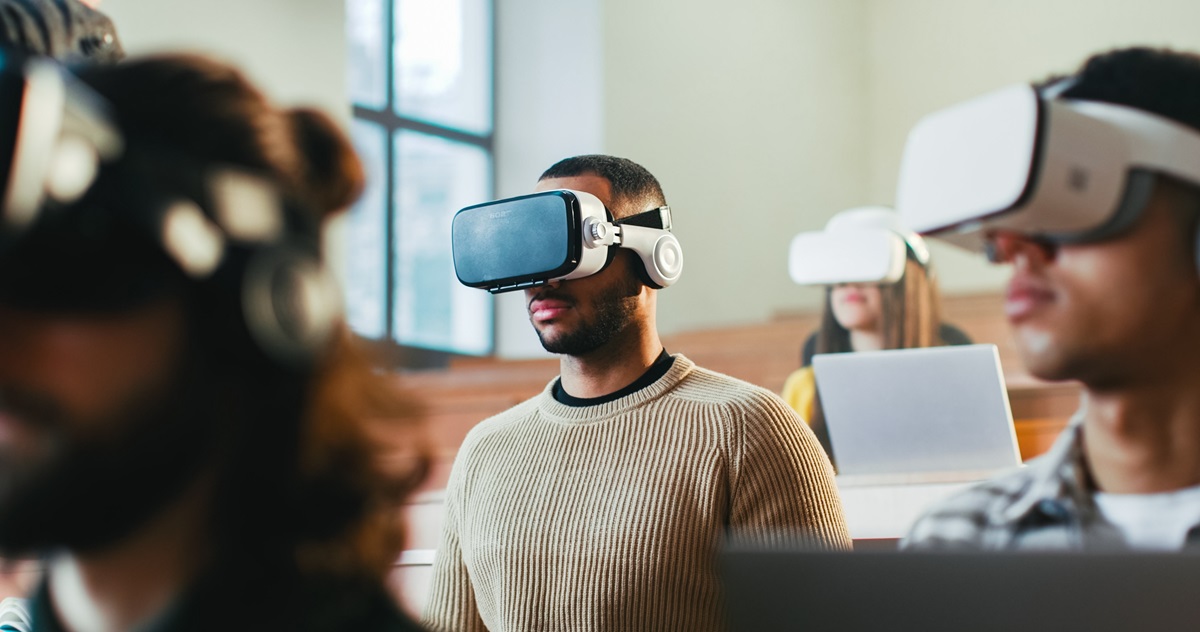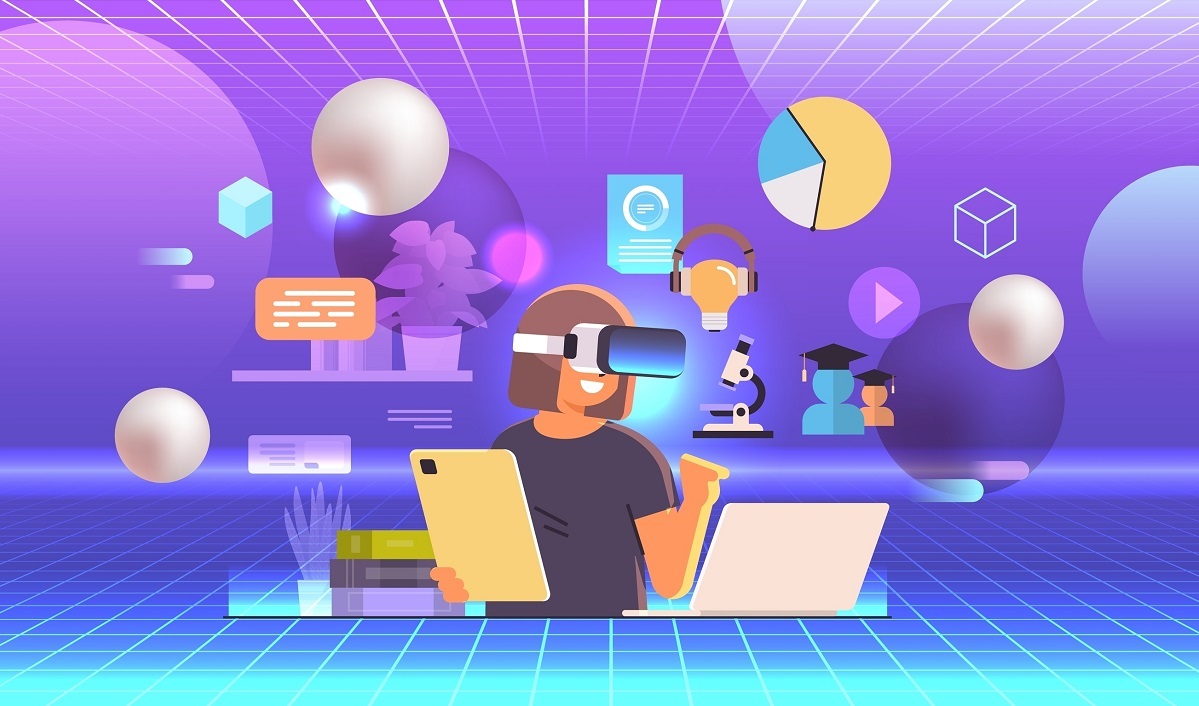Education 4.0: Trends to Look for in Higher Education

In the throes of the Fourth Industrial Revolution, our education system is evolving in unprecedented ways. Dubbed "Education 4.0," this phenomenon is as transformative as Industry 4.0, from which it borrows its name.
Where once traditional methods dominated, now the tides are shifting, blending technology with classic techniques to address the multifaceted needs of today's learners.
From harnessing Artificial Intelligence for personalized learning experiences to the rise of online education, which has seen a surge, especially in the wake of the COVID-19 pandemic, the education sector is a hotbed of innovation.
With Virtual Reality offering immersive experiences and Massive Open Online Courses (MOOCs) democratizing education like never before, the landscape of higher education is being reshaped.
As we delve into the intricacies of Education 4.0, this blog will explore the new trends in education 4.0, including technological advancements, curriculum innovations, social dynamics, and financial paradigms that are currently shaping higher education.
From artificial intelligence-driven adaptive learning platforms to competency-based education models and digital badges, Education 4.0 is redefining traditional approaches to teaching and learning.
So, whether you're an educator, a student, or just someone interested in the future of learning, buckle up – the classroom of the future is here, and it promises to be an exciting journey!!
What is Education 4.0?
Education 4.0 is a term inspired by the Fourth Industrial Revolution, or Industry 4.0, which emphasizes the increasing integration of digital technologies, automation, and the Internet of Things (IoT) into various industries.
In the context of education, Education 4.0 represents the paradigm shifts and advancements in teaching and learning methods that are being driven by these technological revolutions, including the integration of new trends in education 4.0 such as personalized learning algorithms, virtual reality classrooms, artificial intelligence-driven adaptive learning platforms, competency-based education models, and digital badges.
Its Key aspects include-
● Personalized Learning: Customized educational experiences driven by AI and analytics.
● Connected Learning: Digital platforms enabling global student collaboration.
● Blended Learning: A mix of online and offline instruction.
● Experiential Learning: Use of VR and AR for immersive experiences.
● Lifelong Learning: Promoting continuous upskilling and adaptability.
● Democratized Education: MOOCs and online platforms making quality education widely accessible.
● Soft Skills Emphasis: Beyond technical, focusing on skills like critical thinking and emotional intelligence.
● Smart Campuses: IoT-enhanced physical learning environments.
● Real-time Feedback: Instant academic support through advanced analytics.
● Sustainable Learning: Prioritizing eco-friendly practices and sustainability education.
Technological Trends of Education 4.0
Education 4.0 is a holistic approach to learning, blending technology with traditional methods to serve modern needs.
Here are the technological trends to look forward to in Education 4.0-
☑️ Artificial Intelligence in Higher Education

Technology in higher education goes beyond imparting knowledge.
It paves the way for a more inclusive and high-quality learning environment. By eradicating the restrictions of time and place, it champions continuous education, creativity, and collaborative efforts. Artificial Intelligence (AI) spearheads this transformative wave.
The advent of AI in academia has been groundbreaking, streamlining processes that were once tedious. For instance, the Georgia Institute of Technology harnesses the power of AI through tools like 'Jill Watson' to relieve teaching assistants by addressing common student inquiries.
However, while AI's prospects are undeniable, its integration is still a work in progress. Data from 2019 indicated that even though the academic leadership acknowledged the enduring impact of AI, a mere 41% had crystallized their AI approaches.
Financial limitations play a pivotal role, with 57% of institutions refraining from setting aside funds for AI projects (Pells, 2019).
Fast forward to 2023, AI and data analytics in higher education is revolutionizing academic landscapes.
Expanding accessibility horizons, it is also honing in on bespoke and efficient educational experiences. Renowned institutions like the Georgia Institute of Technology are leveraging AI-centric tools to streamline their functionality.
Recent statistics reveal that around 65% of universities have now woven AI strategies into their fabric, a significant leap from the 41% in 2019. Nevertheless, financial barriers persist, with only 45% of institutions allocating budgets for AI-driven innovations.
☑️ Online Learning's Rising Popularity

Online learning has evolved from its e-learning origins, with its expansive world now encompassing both blended and traditional e-learning methods.
At its core, online education harnesses the power of the internet, offering learners the flexibility to pursue knowledge unfettered by geographical constraints, rigid schedules, or the need for physical presence.
Currently, a staggering 80% of college attendees are from the digitally native Gen Z and emerging Alpha generations.
Research shows that a near-universal 99% of them possess smartphones, with virtually all of them engaging with major online platforms. These tech-adept students naturally lean into online learning, blending seamlessly with the digital educational landscape.
The aftermath of the COVID-19 pandemic has amplified this inclination, evidenced by the fact that nearly half, or 45%, of all students, are now enrolled in at least one online module.
The advanced internet infrastructure and cutting-edge virtual technologies further augment the attractiveness and efficacy of online education in this era.
☑️ Virtual Reality in Education

Virtual Reality (VR) is seen as transformative in higher education, with the education sector being a major recipient of VR investments in 2018 (Perkinscoie, 2018).
Educators leverage the potential of virtual reality in higher education, like heightened engagement, contextualized learning, and unique experiential opportunities, especially in the science and medical sectors.
Such immersion often leads to deeper understanding and empathy among students.
By 2018, 18% of universities fully adopted VR, 28% used it partially, and 32% were exploring its potential (Burroughs, 2018; Internet2, 2019). This trend is expected to rise.
Arizona State University, for instance, utilizes VR for online lab sessions in its biological science program, joining others like San Jose State University and the University of Illinois in embracing this tech.
By 2023, 36% of universities had wholly integrated VR, 40% were partially using it, and 20% were evaluating its potential. Institutions, including Arizona State University, are intensifying VR's usage to foster richer online academic experiences.
This means that the adoption of the metaverse in higher education continues to grow.
☑️ Collaborative Learning
Emerging trends in educational technology have bridged distances, ensuring everyone remains interconnected. Modern ICT developments in education have opened up various avenues, fostering collective action, dialogue, and decision-making.
Collaboration has become a cornerstone of today's learning methodology. Within classrooms, educators amplify this spirit of teamwork by assigning group projects and assignments.
By coming together for projects or problem-solving, students hone their team dynamics. This joint effort enhances comprehension and boosts involvement.
While eLearning has gained momentum, it prioritizes collaboration through features that promote sharing and discussion. Gone are the days when teachers would simply lecture for 30 minutes and leave at the sound of the bell.
Now, technology has fostered a deeper connection between educators and learners.
It's common to see educators and students communicating more frequently. Teachers, now easily approachable, play the role of guides, fostering holistic student growth. Such cooperative learning environments empower students to engage with peers and develop essential social skills.
Curriculum Trends of Education 4.0
Curriculum trends to look forward to in Education 4.0 are given below-
☑️ Addressing the Skills Gap
Mauricio Macri, speaking at the G20 summit in 2018, highlighted the race between technology and education. As tech evolves, education must adapt and prepare students for the digital workforce.
Higher education institutions should equip students with skills the labor market demands, leading to the need to redesign courses and curricula to align with modern trends (Educause Horizon Report, 2020).
The Fourth Industrial Revolution, driven by innovations like Virtual Reality labs, is widening skill gaps in all sectors as it allows simulation-based learning.
By 2022, the interplay between machines and humans has created 133 million new roles globally. The tech-driven workplace increases the demand for diverse skills.
Universities are now partnering with companies to address this gap. Stanford University, for instance, gives over 40 corporate departments direct access to its students (New, 2016).
Additionally, the rise of Competency-Based Education (CBE) caters to individual student needs, focusing on diverse skills. Universities like Capella and Western Governors have shifted from traditional learning outcomes to competencies (Fain, 2019).
As the Fourth Industrial Revolution matures, universities recalibrate curricula to bridge skill gaps. Projections indicate that by 2025, over 200 million new roles will emerge, primarily driven by AI and automation.
Universities like Stanford continue to collaborate with industry giants to enhance student preparedness for these evolving requirements.
☑️ Leveraging Gamification in Learning
Recent advancements in ed-tech are gaining traction, primarily due to their capability to amplify student engagement. Gamification, characterized by leaderboards, point systems, badges, and stickers, stands out among these trends for its proven effectiveness in boosting participation, engagement, and competitive spirit.
Such methods inspire students to dive deeper into classroom tasks, driven by the desire to climb leaderboards and enhance their scores. This drive not only leads to improved performance but also fosters better content retention.
By gamifying educational content, educators can fuel students' motivation, fostering a dynamic and interactive learning environment. The end result? Elevated student morale and a continual push for excellence.
This gamified approach is poised for further innovation, refining the educational paradigm.
☑️ The Rise of MOOCs
MOOCs (Massive Open Online Courses) offer free, large-scale, and globally accessible education online. They've rapidly grown in the education sector, transforming the traditional higher education model.
Unlike regular online courses, MOOCs have no enrollment cap and minimal prerequisites, making education more affordable. They aren't confined to semester timings, allowing students to start anytime and often focus on specific topics.
Leading universities are releasing MOOCs to enhance education accessibility.
In 2019, MOOC platforms introduced 2,500 courses, 170 micro-credentials, and 11 online degrees, reaching over 110 million learners outside China. Platforms like Coursera, edX, Udacity, FutureLearn, and Swayam collaborate with top institutions to address today's educational challenges."
Today, MOOCs' impact persists.
In 2023, platforms released approximately 3,200 courses, 240 micro-credentials, and 20 online degrees, reaching nearly 140 million global learners. Their partnerships with elite institutions remain crucial in democratizing education.
International Student Enrollment in the U.S.
U.S. universities saw a declining trend in new international student enrollments in 2019, with 51% of institutions noting a decrease. While 7% reported no change, 42% saw an increase (IIE, 2020).
The IIE reported a total 0.9% drop in 2019. As U.S. schools struggle, countries like Australia and Canada benefit. Australia reported a 47% enrollment rise from 2015 to 2018 (Australia Government Data, 2018).
Factors for the U.S. decline include intensified global education competition, socio-political environment, high education costs, and visa issues. Policies like the ban on Chinese students and visa restrictions have notably affected enrollments (Anderson, 2018; BAL, 2018).
New international student enrollments in U.S. universities in 2023 show a mixed trend.
45% of institutions observed a decline, 50% reported an increase, and 5% saw no change. The overall drop marginally improved to 0.7%. Australia's surge continues, with a staggering 55% enrollment increase from 2015 to 2023.
Financial Trends of Education 4.0
Financial Trends to look forward to in Education 4.0 are given below-
☑️ Shift in Fundraising Trends for Higher Education
The Giving USA report notes a 3.7% drop in overall donations to higher education institutions in 2018. However, contributions to these institutions surged by 7.2% to $46.73 billion. Remarkably, seven institutions received donations of over $100 million that year—the highest since 2015.
While large donations are on the rise, individual alumni contributions are declining.
Even with increased total donations, fewer individuals are donating. Michael Bloomberg's $1.8 billion gift to John Hopkins University underscores this evolving trend: fewer donors, but more generous gifts."
Donations to higher education institutions in 2023 reached $52 billion, with ten institutions receiving gifts of over $120 million. Despite this, the trend of fewer individuals donating larger sums continues.
☑️ Alternate Funding for Higher Education in the U.S.
U.S. higher education institutions have depended heavily on varying federal funding, with a national increase of 5% in 2019/2020, reaching $96.6 billion (Grapevine, 2020).
However, this masked funding cuts in states like Alaska by 11.2%, Hawaii by 2.2%, and New York by 0.3% (Grapevine, 2020). These reductions force institutions to seek alternative funding sources.
Public universities now engage businesses and private entities for support. For instance, Northeastern University partnered with tech entrepreneur David Roux to establish The Roux Institute, funded by a $100 million donation from Roux, focusing on AI and machine learning (Northeastern University, 2020).
By 2023, federal funding for U.S. higher education rose to $101 billion, a modest increase from 2019/2020. Yet, funding disparities persist. More universities, like Northeastern, are forging industry partnerships to navigate these fiscal challenges and remain at the forefront of educational innovation.
Social Trends of Education 4.0
Social Trends to look forward to in Education 4.0 are given below-
☑️ Diversity in Higher Education

Universities aim to boost student success and prepare them for a competitive workforce. Achieving this requires institutions to create diverse and inclusive campuses and acknowledge the significance of racial and ethnic diversity in education (U.S. Department of Education, 2016).
Despite many institutions professing commitment to diversity, only a few genuinely acted on it initially.
By the 1980s, students of color represented 17.33% of undergraduates (National Center for Education Statistics, 2019). The 1990s saw an increased emphasis on inclusivity, with the percentage of students of color rising to 29.6% in 1996 and 45.2% by 2016 (American Council on Education, 2019).
This increase is attributed to globalization, immigration, and active diversification efforts in academia.
Furthermore, 23% of higher education roles in the U.S. are occupied by racial and ethnic minorities, with varied representation across departments (College and University Professional Association for Human Resources, 2020).
Notably, women now make up 60% of higher education professionals, with a significant presence in academic affairs (69%).
By 2023, students of color represented nearly 53.4% of undergraduates.
University campuses continue to prioritize inclusivity and diversity, not just in enrollments but also in staff appointments, with around 30% of higher education roles occupied by racial and ethnic minorities.
☑️ Rise of Non-Traditional Students
Historically, "university" and "college student" primarily denoted 18-24 year-olds fresh from high school, often reliant on parental support (Hittepole, 2018). However, the 2008 Great Recession highlighted the value of higher education when 80% of job losses impacted those without post-high school education (Carnevale et al., 2011).
This prompted a diverse group, including full-time workers and retirees, to seek higher education. In response, institutions adapted their models for these non-traditional students. By 2015, they constituted 40% of undergraduates in American colleges (CLASP, 2015).
In 2023, Non-traditional students now make up nearly 45% of the undergraduate population in the U.S. Their growth, propelled by flexible learning modes like online courses and micro-credentials, is revolutionizing the university demographic landscape.
☑️ Mental Health Awareness in Colleges
Mental health challenges among college students are described as a "crisis." The American Psychological Association found that 35% of first-year students across eight countries grapple with mental health issues.
Worryingly, student stress figures in the U.S. reflect this-
In 2019, of the 20 million students in higher education institutions, 19.9 million faced mental health issues, with issues like depression, anxiety, and addiction being prevalent (Imagine America Foundation, 2020).
The American College Health Association reported that 60% and 40% of students experienced anxiety and depression respectively (ACHA, 2019). As of 2023, over 29 million students were grappling with some form of mental health issue.
In response, universities are adopting novel methods to promote mental health awareness. They introduce mental health topics early, during orientation, using tools like discussions, role-playing, and videos.
Evidence suggests such interventions enhance students' emotional well-being.
Institutions, like Drexel University, provide free mental health screenings. With their slogan "Get a checkup from the neck up," students are encouraged to undergo a brief assessment, followed by access to mental health resources.
☑️ International Student Enrollment Trends-
U.S. universities witnessed a declining trend in new international student enrollment.
In 2019, 51% of these institutions reported a decrease, while 42% saw an increase, and 7% observed no change (IIE, 2020). The overall drop was estimated at 0.9%.
Meanwhile, countries like Australia experienced a surge, with a 47% enrollment increase from 2015 to 2018 (Australia Government Data, 2018).
Factors behind the U.S. decline include increased global education competition, socio-political atmosphere, high tuition, visa issues, and specific restrictions on Chinese students (Anderson, 2018; BAL, 2018).
The trend from 2019 of declining new international student enrollments in U.S. universities persists.
However, the pace of decline has reduced, with only a 0.7% drop in 2023. On the other hand, countries like Australia still experience booming international student numbers.
Conclusion
The intersection of technology with education has ushered in avenues previously thought impossible. From AI-enhanced personalized learning to the expansive world of online education, the scope and reach of learning have expanded exponentially.
These advancements not only democratize education but also ensure its relevance in a fast-paced, digitally-driven world.
Moreover, the focus is no longer just on acquiring knowledge but on the holistic development of learners, emphasizing skills like critical thinking, adaptability, and emotional intelligence.
The challenges faced by institutions, whether financial or curriculum-based, are being met with innovative solutions that prioritize student needs and future preparedness.
In essence, as we navigate the intricate maze of Education 4.0, we stand at the cusp of a revolution – one that holds the promise of reshaping the future of learning.
It's a future where learning is not just confined to the four walls of a classroom but is an ever-evolving journey, adapting and transforming with the needs of the global society. This future beckons with endless possibilities, and it's up to us to embrace and shape it.




